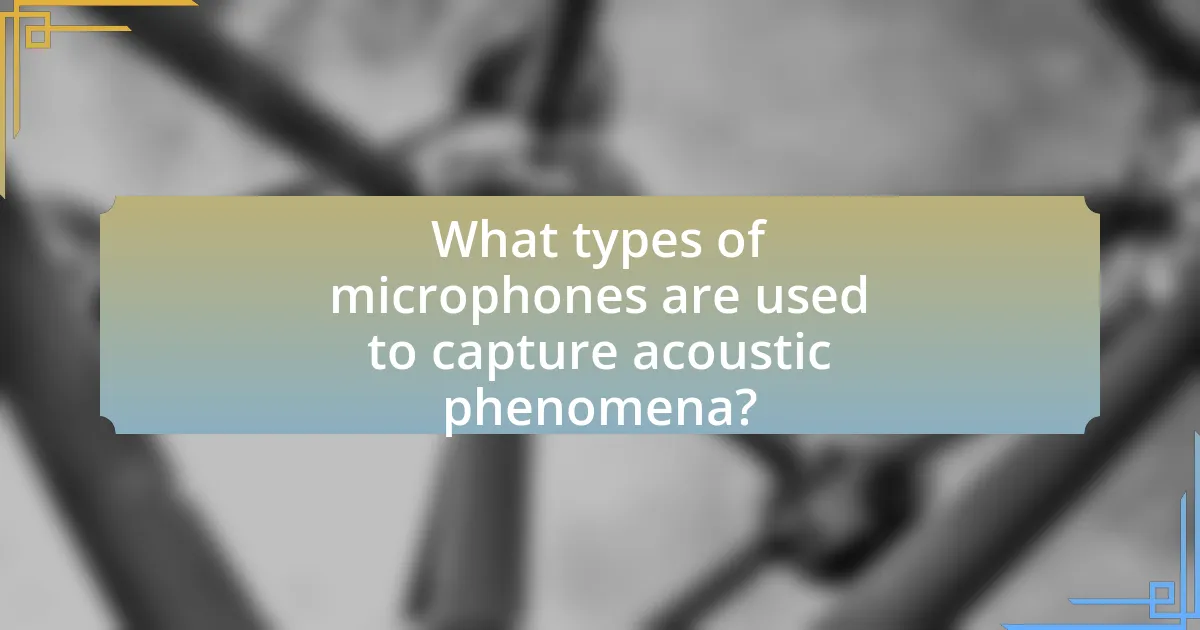Microphones are essential devices that convert sound waves into electrical signals, playing a pivotal role in capturing various acoustic phenomena. This article explores the mechanics of how microphones function, detailing the transduction process involving diaphragms and different types of transducers, such as dynamic, condenser, and ribbon microphones. It also examines the impact of microphone specifications, including sensitivity and frequency response, on sound quality, and discusses the challenges faced in sound capture, such as background noise and equipment limitations. Additionally, the article highlights the significance of microphones across multiple industries, including entertainment, telecommunications, and healthcare, while addressing future trends in microphone technology driven by digital advancements and artificial intelligence.

What is the role of microphones in capturing acoustic phenomena?
Microphones convert sound waves into electrical signals, playing a crucial role in capturing acoustic phenomena. They achieve this by using a diaphragm that vibrates in response to sound pressure, which then generates an electrical current proportional to the sound’s amplitude and frequency. This process allows for the accurate representation of various acoustic events, such as speech, music, and environmental sounds, enabling their recording, amplification, and transmission. The effectiveness of microphones in this role is evidenced by their widespread use in diverse applications, including broadcasting, music production, and scientific research, where precise sound capture is essential for analysis and communication.
How do microphones convert sound waves into electrical signals?
Microphones convert sound waves into electrical signals through a transduction process. When sound waves, which are variations in air pressure, reach the microphone, they cause a diaphragm within the microphone to vibrate. This diaphragm is connected to a transducer, which can be either a dynamic coil, a condenser plate, or a piezoelectric crystal, depending on the microphone type.
In dynamic microphones, the diaphragm’s movement induces a current in a coil of wire placed within a magnetic field, generating an electrical signal that corresponds to the sound wave. In condenser microphones, the diaphragm’s movement changes the capacitance between two plates, creating an electrical signal. Piezoelectric microphones generate a voltage when the diaphragm vibrates due to sound waves.
These processes effectively transform acoustic energy into electrical energy, allowing for the capture and amplification of sound.
What are the key components of a microphone that facilitate this conversion?
The key components of a microphone that facilitate the conversion of sound waves into electrical signals are the diaphragm, transducer, and housing. The diaphragm is a thin membrane that vibrates in response to sound waves, converting acoustic energy into mechanical energy. The transducer, which can be a dynamic, condenser, or ribbon type, then converts this mechanical energy into electrical energy. The housing protects these components and influences the microphone’s acoustic properties. These components work together to ensure accurate sound capture, as evidenced by the varying designs tailored for specific applications, such as studio recording or live performance.
How do different microphone types affect the quality of sound capture?
Different microphone types significantly affect the quality of sound capture due to their design and functionality. Dynamic microphones, for example, are robust and handle high sound pressure levels well, making them ideal for live performances, but they may lack the sensitivity and frequency response of condenser microphones, which excel in studio settings by capturing a wider range of frequencies and subtle nuances. Ribbon microphones, known for their warm sound, can provide a unique tonal quality but are more fragile and less versatile in high-volume situations. Each type’s construction—such as diaphragm size and material—directly influences its ability to accurately reproduce sound, with condenser microphones typically offering better transient response and detail. This variance in design and application leads to distinct sound characteristics, impacting the overall audio quality captured in different environments.
Why are microphones essential in various fields?
Microphones are essential in various fields because they convert sound waves into electrical signals, enabling effective communication and sound recording. In broadcasting, microphones facilitate clear audio transmission, which is crucial for radio and television programs. In music production, they capture vocals and instruments with precision, allowing for high-quality recordings. Additionally, in research and development, microphones are used in acoustic studies to analyze sound properties and behaviors. Their versatility and functionality make them indispensable tools across industries such as entertainment, education, and scientific research.
What industries rely heavily on microphones for acoustic phenomena capture?
The industries that rely heavily on microphones for acoustic phenomena capture include the entertainment industry, telecommunications, healthcare, and research and development. In the entertainment industry, microphones are essential for recording music, broadcasting, and live performances, enabling clear audio capture. Telecommunications utilize microphones for voice communication in devices like smartphones and conferencing systems, ensuring effective transmission of sound. In healthcare, microphones are used in medical devices such as stethoscopes and telemedicine applications to capture and analyze bodily sounds. Research and development sectors employ microphones in various scientific studies, including acoustics research and environmental monitoring, to gather precise audio data for analysis.
How do microphones enhance communication and recording in these industries?
Microphones enhance communication and recording in various industries by converting sound waves into electrical signals, enabling clear audio capture and transmission. In broadcasting, high-quality microphones ensure that voices are transmitted without distortion, which is crucial for maintaining audience engagement. In the music industry, microphones capture the nuances of vocal and instrumental performances, allowing for high-fidelity recordings that reflect the artist’s intent. In film and television, directional microphones isolate dialogue from background noise, improving the overall sound quality and viewer experience. The effectiveness of microphones is supported by advancements in technology, such as condenser and dynamic microphones, which are designed for specific applications, ensuring optimal performance in diverse environments.

What types of microphones are used to capture acoustic phenomena?
Dynamic microphones, condenser microphones, and ribbon microphones are commonly used to capture acoustic phenomena. Dynamic microphones are robust and handle high sound pressure levels, making them ideal for live sound applications. Condenser microphones are sensitive and provide a wider frequency response, which is beneficial for studio recordings and capturing subtle acoustic details. Ribbon microphones offer a warm sound and are particularly effective for capturing the nuances of acoustic instruments. Each type serves specific purposes based on their design and functionality, ensuring accurate representation of sound in various environments.
What are the main categories of microphones?
The main categories of microphones are dynamic, condenser, ribbon, and lavalier microphones. Dynamic microphones utilize a diaphragm attached to a coil of wire, which moves within a magnetic field to generate an electrical signal, making them durable and suitable for live sound applications. Condenser microphones use a diaphragm placed close to a backplate, creating capacitance changes that produce audio signals; they are sensitive and ideal for studio recordings. Ribbon microphones feature a thin metal ribbon suspended in a magnetic field, providing a warm sound quality, often used in studio settings. Lavalier microphones, also known as lapel mics, are small and clip onto clothing, commonly used in interviews and presentations for hands-free operation. These categories reflect the diverse applications and technologies in microphone design, catering to various acoustic capturing needs.
How do dynamic microphones differ from condenser microphones?
Dynamic microphones differ from condenser microphones primarily in their transducer technology and sensitivity. Dynamic microphones utilize a moving coil and diaphragm system, making them more robust and suitable for high sound pressure levels, while condenser microphones employ a capacitor that requires external power, resulting in greater sensitivity and a wider frequency response. This distinction means that dynamic microphones are often preferred for live sound applications due to their durability and feedback rejection, whereas condenser microphones are favored in studio settings for their clarity and detail in capturing subtle nuances of sound.
What are the advantages of ribbon microphones in acoustic capture?
Ribbon microphones offer several advantages in acoustic capture, primarily their natural sound reproduction and sensitivity to high frequencies. These microphones utilize a thin metal ribbon suspended in a magnetic field, which allows them to capture sound waves with a smooth frequency response, particularly excelling in the mid and high ranges. This design results in a warm, vintage tone that is often preferred for recording vocals and acoustic instruments. Additionally, ribbon microphones are known for their ability to handle high sound pressure levels without distortion, making them suitable for loud sources like brass instruments and guitar amplifiers. Their figure-eight polar pattern also provides excellent off-axis rejection, allowing for clearer recordings in environments with multiple sound sources.
How do microphone specifications impact their performance?
Microphone specifications significantly impact their performance by determining sensitivity, frequency response, and signal-to-noise ratio. Sensitivity indicates how effectively a microphone converts sound waves into electrical signals; for instance, a microphone with high sensitivity captures quieter sounds more accurately. Frequency response defines the range of frequencies a microphone can capture, affecting its ability to reproduce sound accurately across different pitches; a microphone with a flat frequency response is ideal for capturing a wide range of sounds without coloration. The signal-to-noise ratio measures the level of the desired signal compared to background noise; a higher ratio means clearer audio capture, essential in professional settings. These specifications collectively influence the microphone’s suitability for various applications, such as studio recording, live performances, or field recordings, ensuring optimal sound quality and fidelity.
What role does frequency response play in microphone selection?
Frequency response is crucial in microphone selection as it determines the range of frequencies a microphone can accurately capture. A microphone with a flat frequency response will reproduce sound more faithfully across the audible spectrum, which is essential for applications like music recording and broadcasting. For instance, a microphone that effectively captures frequencies from 20 Hz to 20 kHz is suitable for most audio applications, ensuring that both low bass and high treble sounds are represented accurately. This characteristic influences the overall sound quality and clarity, making it a key factor in choosing the right microphone for specific acoustic phenomena.
How does sensitivity affect the microphone’s ability to capture sound?
Microphone sensitivity directly influences its ability to capture sound by determining how effectively it converts acoustic pressure into an electrical signal. Higher sensitivity allows a microphone to pick up quieter sounds and nuances in audio, making it suitable for applications like recording soft vocals or ambient noise. For instance, a microphone with a sensitivity rating of -30 dBV/Pa can capture sounds at lower volumes compared to one rated at -50 dBV/Pa, which would require louder sounds to achieve the same output level. This relationship is crucial in various audio applications, as it affects the overall fidelity and clarity of the recorded sound.

What are the challenges in capturing acoustic phenomena with microphones?
Capturing acoustic phenomena with microphones presents several challenges, including background noise interference, frequency response limitations, and sensitivity to environmental factors. Background noise can obscure the desired sound, making it difficult to isolate specific acoustic events. Frequency response limitations arise because different microphones have varying capabilities to capture a range of frequencies, which can lead to distortion or loss of important sound details. Additionally, environmental factors such as temperature, humidity, and wind can affect microphone performance, altering sound quality and accuracy. These challenges necessitate careful selection and placement of microphones to ensure optimal sound capture.
What common issues arise during sound capture?
Common issues that arise during sound capture include background noise, microphone placement, and equipment malfunction. Background noise can interfere with the desired audio, making it difficult to isolate the primary sound source. Improper microphone placement can lead to poor sound quality, such as distortion or an unbalanced mix of sounds. Equipment malfunction, including issues with cables or power sources, can result in loss of audio or degraded sound quality. These factors are critical to consider for effective sound capture in various environments.
How can background noise interfere with microphone performance?
Background noise can significantly interfere with microphone performance by introducing unwanted sound that masks the intended audio signal. This interference can lead to reduced clarity and intelligibility of the primary sound source, making it difficult for listeners to discern speech or music. Studies show that microphones are designed to capture specific frequencies, and background noise often overlaps with these frequencies, resulting in distortion or a muddy sound quality. For instance, a study published in the Journal of the Acoustical Society of America indicates that background noise levels above 60 decibels can severely impact speech recognition scores in various environments.
What techniques can be used to minimize distortion in recordings?
To minimize distortion in recordings, techniques such as proper microphone placement, using high-quality microphones, and employing appropriate gain staging are essential. Proper microphone placement reduces unwanted reflections and captures sound more accurately, while high-quality microphones are designed to handle a wider dynamic range, thus minimizing distortion. Additionally, gain staging ensures that audio levels are optimized throughout the recording chain, preventing clipping and distortion. These methods are supported by audio engineering principles that emphasize clarity and fidelity in sound capture.
How can users optimize microphone usage for better acoustic capture?
Users can optimize microphone usage for better acoustic capture by positioning the microphone correctly, using appropriate settings, and minimizing background noise. Proper positioning involves placing the microphone close to the sound source to capture clearer audio, as proximity enhances the signal-to-noise ratio. Adjusting settings such as gain and equalization can further refine audio quality, allowing for better frequency response tailored to the environment. Additionally, employing soundproofing techniques or using directional microphones can significantly reduce unwanted ambient noise, ensuring that the desired sound is captured more effectively. These practices are supported by audio engineering principles that emphasize the importance of microphone placement and environmental control in achieving high-quality acoustic recordings.
What best practices should be followed when positioning microphones?
To achieve optimal sound capture, microphones should be positioned to minimize background noise and maximize direct sound from the source. This involves placing the microphone close to the sound source while avoiding obstructions that can cause reflections or interference. For instance, positioning a microphone at a distance of 6 to 12 inches from a vocalist can enhance clarity and reduce ambient noise, as supported by audio engineering principles. Additionally, using directional microphones can help focus on the intended sound source while rejecting off-axis noise, further improving audio quality. Properly angling the microphone towards the sound source also enhances the capture of desired frequencies, ensuring a more accurate representation of the acoustic phenomena.
How can users select the right microphone for specific acoustic environments?
Users can select the right microphone for specific acoustic environments by considering the microphone type, polar pattern, frequency response, and sensitivity. Different environments, such as live venues or studio settings, require microphones that can effectively capture sound while minimizing unwanted noise. For instance, dynamic microphones are ideal for high-volume environments due to their durability and ability to handle loud sounds without distortion, while condenser microphones are better suited for studio recordings where detail and clarity are paramount. Additionally, selecting a microphone with an appropriate polar pattern, such as cardioid for isolating sound from a specific direction, can enhance performance in challenging acoustic settings. The frequency response should also match the sound source; for example, a microphone with a flat frequency response is ideal for capturing vocals accurately.
What are the future trends in microphone technology for capturing acoustic phenomena?
Future trends in microphone technology for capturing acoustic phenomena include advancements in digital signal processing, miniaturization, and the integration of artificial intelligence. Digital signal processing enhances sound quality and noise reduction, allowing for clearer recordings in various environments. Miniaturization enables the development of smaller, more portable microphones without compromising performance, making them ideal for mobile applications. The integration of artificial intelligence facilitates real-time sound analysis and adaptive filtering, improving the microphone’s ability to capture specific acoustic phenomena accurately. These trends are supported by ongoing research and development in audio technology, indicating a shift towards more intelligent and versatile microphone systems.
How is digital technology influencing microphone design and functionality?
Digital technology is significantly influencing microphone design and functionality by enabling advanced features such as digital signal processing (DSP), improved noise cancellation, and enhanced connectivity options. These advancements allow microphones to capture sound with greater clarity and precision, as DSP algorithms can filter out unwanted noise and enhance desired audio frequencies. For instance, modern microphones often incorporate USB connectivity, allowing for direct integration with computers and digital audio workstations, which streamlines the recording process. Additionally, the use of MEMS (Micro-Electro-Mechanical Systems) technology in microphone design has led to smaller, more efficient microphones that maintain high audio quality, as evidenced by their widespread adoption in smartphones and other portable devices.
What innovations are expected to enhance microphone performance in the coming years?
Innovations expected to enhance microphone performance in the coming years include advancements in digital signal processing, improved materials for better sound capture, and the integration of artificial intelligence for noise reduction. Digital signal processing technologies will allow microphones to filter out unwanted sounds and enhance voice clarity, as evidenced by the increasing use of DSP in consumer electronics. New materials, such as graphene and MEMS (Micro-Electro-Mechanical Systems), are being researched for their ability to provide greater sensitivity and frequency response, which has been shown to improve audio fidelity in laboratory tests. Additionally, AI algorithms are being developed to analyze sound patterns and adapt microphone settings in real-time, leading to more effective noise cancellation and sound enhancement, as demonstrated in recent prototypes by leading audio technology companies.





